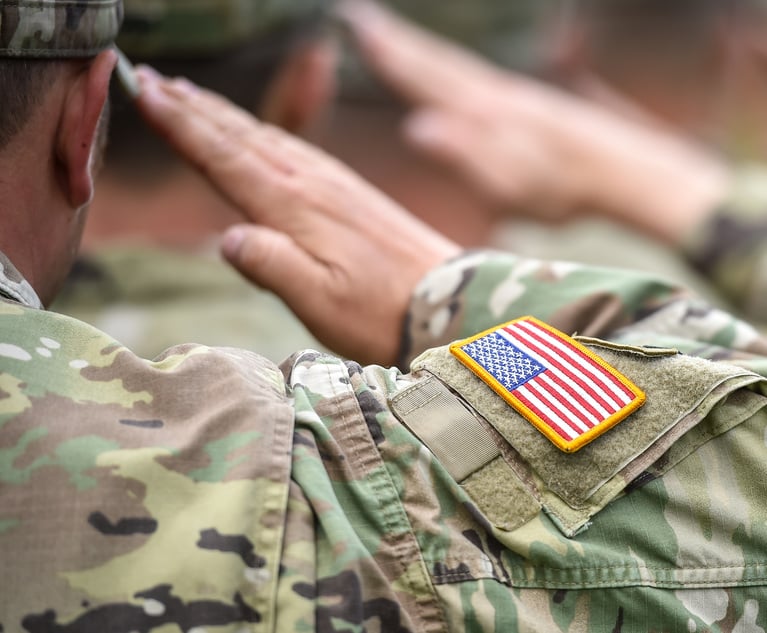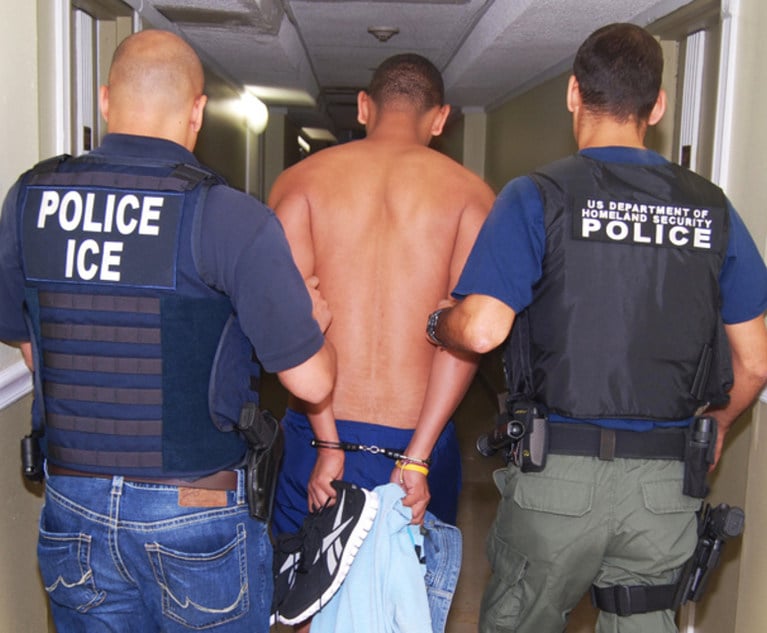The Families First Coronavirus Response Act
On Wednesday, Congress approved and President Donald Trump signed the Families First Coronavirus Response Act (FFCRA). FFCRA provides new benefits…
March 20, 2020 at 07:42 PM
5 minute read
 From left, Sameer Karim, Devon Sharp and Brenna Lermon are attorneys at Munsch Hardt.
From left, Sameer Karim, Devon Sharp and Brenna Lermon are attorneys at Munsch Hardt.
On Wednesday, Congress approved and President Donald Trump signed the Families First Coronavirus Response Act (FFCRA). FFCRA provides new benefits to employees through two new laws: the Emergency Family and Medical Leave Expansion Act (EFMLEA) and the Emergency Paid Sick Leave Act (EPSLA). The requirements of FFCRA are set to take effect April 2 and expire Dec. 31. The elements of FFCRA that touch most directly on the employer-employee relationship are examined below.
EMERGENCY FAMILY AND MEDICAL LEAVE EXPANSION ACT
EFMLEA amends the Family and Medical Leave Act (FMLA) to require covered employers to provide up to 12 weeks of protected paid leave to eligible employees for a qualifying reason.
- Eligible Employees: Those who have been employed for 30 days.
- Covered Employers: Private employers with fewer than 500 employees and all public sector employers, but carve-outs exist regarding certain provisions for smaller businesses, and EFMLEA gives the Secretary of Labor (DOL) the authority to exempt even more small businesses and certain healthcare and emergency personnel. How the DOL will exercise this authority remains unclear.
- Qualifying Reason: The employee is unable to work (or telework) due to the need to care for the employee's child, because the child's school or place of care has been closed, or is unavailable, due to a public emergency.
- Compensation: The initial 10 days of leave may be unpaid, except that an employee may substitute any available paid leave for this unpaid leave. After the initial 10 days, the employer must provide paid leave equal to two-thirds of the employee's regular rate of pay for the remainder of the leave. For employees with varying schedules and pay, the paid leave must be equal to the average number of hours the employee was scheduled to work per day over the prior six-month period. In no event shall the total value of paid leave taken by an employee exceed $200/day or $10,000 in the aggregate.
EMERGENCY PAID SICK LEAVE ACT
EPSLA requires covered employers to provide eligible employees with paid leave when a qualifying reason exists or has been triggered.
- Covered Employers: Private employers with fewer than 500 employees and all public sector employers. Health care provider and emergency responder employers may be entitled to exclude their employees from this provision.
- Eligible Employees: All employees, regardless of their length of employment.
- Paid Leave: Employers must provide full-time employees with 80 hours of paid sick leave and part-time employees with two weeks of paid sick leave based on the average number of hours the employee worked during the prior six-month period.
- For paid leave taken for self-care (reasons 1–3, below), the employee is entitled to paid leave at the employee's regular rate, capped at $511/day and $5,110 in the aggregate.
- For paid leave taken to care of another individual (reasons 4–6 below), the employee is entitled paid leave at two-thirds of the employee's regular rate, capped at $200/day and $2,000 in the aggregate.
- Qualifying Reasons: An employee qualifies for EPSLA if the employee,
- is subject to a federal, state or local quarantine related to COVID-19;
- has been advised by a health care provider to self-quarantine due to concerns related to COVID-19;
- is experiencing symptoms of COVID-19 and is seeking a medical diagnosis;
- is caring for an individual (not limited to family member) who is subject to qualifying reasons (1) or (2) above;
- is caring for a child while the child's school or place of care is closed, or the employee's child care provider is unavailable, due to COVID-19 precautions; or
- is experiencing any other substantially similar condition specified by the Secretary of Health and Human Services in consultation with the Secretary of the Treasury and the DOL.
HOW WILL EMPLOYERS PAY FOR THESE BENEFITS?
Employers are responsible for all payments owed to qualifying and covered employees under both EFMLEA and EPSLA. However, the act provides a quarterly tax credit to employers (and certain self-employed individuals) to offset the cost of paid family and sick leave. Specifically, employers are eligible for a refundable tax credit of 100% of qualified family leave wages paid and sick leave wages paid against their employer-side payroll tax liability. If the credit value exceeds the employer's quarterly tax liability, the act provides that the excess will be treated as an overpayment and refunded.
FINAL THOUGHTS
FFCRA is the first of what is likely to be many measures adopted to assist Americans during these challenging times. Congress has been outspoken about the need to pass additional measures, including potential amendments to the Act. And while many appreciate the speed with which the legislature moved in enacting FFCRA, there has been much criticism of the act for exempting large employers and placing a potentially insurmountable burden on small- and medium-sized employers. As a result, the act could be modified further at any time, and the information in this article is subject to change before the Act takes effect.
Sameer Karim is a shareholder in Munsch Hardt Kopf & Harr's Houston office. He counsels and represents employers and executives in matters involving the protection of trade secret and confidential information, noncompete agreements, discrimination, harassment and wage and hour disputes.
Devon Sharp is a shareholder in Munsch Hardt's Dallas office. Her practice focuses on employment law and business litigation. She is a trusted counselor and litigator with a proven track record of advising and defending companies of all sizes and types.
Brenna Lermon is an associate in Munsch Hardt's Houston office. Her practice focuses on general commercial and employment law arbitrations and litigation in state and federal court. She also regularly represents employers in responding to government agency investigations.
This content has been archived. It is available through our partners, LexisNexis® and Bloomberg Law.
To view this content, please continue to their sites.
Not a Lexis Subscriber?
Subscribe Now
Not a Bloomberg Law Subscriber?
Subscribe Now
NOT FOR REPRINT
© 2025 ALM Global, LLC, All Rights Reserved. Request academic re-use from www.copyright.com. All other uses, submit a request to [email protected]. For more information visit Asset & Logo Licensing.
You Might Like
View All

Lawyers' Phones Are Ringing: What Should Employers Do If ICE Raids Their Business?
6 minute read

Read the Document: DOJ Releases Ex-Special Counsel's Report Explaining Trump Prosecutions
3 minute readLaw Firms Mentioned
Trending Stories
- 1Uber Files RICO Suit Against Plaintiff-Side Firms Alleging Fraudulent Injury Claims
- 2The Law Firm Disrupted: Scrutinizing the Elephant More Than the Mouse
- 3Inherent Diminished Value Damages Unavailable to 3rd-Party Claimants, Court Says
- 4Pa. Defense Firm Sued by Client Over Ex-Eagles Player's $43.5M Med Mal Win
- 5Losses Mount at Morris Manning, but Departing Ex-Chair Stays Bullish About His Old Firm's Future
Who Got The Work
J. Brugh Lower of Gibbons has entered an appearance for industrial equipment supplier Devco Corporation in a pending trademark infringement lawsuit. The suit, accusing the defendant of selling knock-off Graco products, was filed Dec. 18 in New Jersey District Court by Rivkin Radler on behalf of Graco Inc. and Graco Minnesota. The case, assigned to U.S. District Judge Zahid N. Quraishi, is 3:24-cv-11294, Graco Inc. et al v. Devco Corporation.
Who Got The Work
Rebecca Maller-Stein and Kent A. Yalowitz of Arnold & Porter Kaye Scholer have entered their appearances for Hanaco Venture Capital and its executives, Lior Prosor and David Frankel, in a pending securities lawsuit. The action, filed on Dec. 24 in New York Southern District Court by Zell, Aron & Co. on behalf of Goldeneye Advisors, accuses the defendants of negligently and fraudulently managing the plaintiff's $1 million investment. The case, assigned to U.S. District Judge Vernon S. Broderick, is 1:24-cv-09918, Goldeneye Advisors, LLC v. Hanaco Venture Capital, Ltd. et al.
Who Got The Work
Attorneys from A&O Shearman has stepped in as defense counsel for Toronto-Dominion Bank and other defendants in a pending securities class action. The suit, filed Dec. 11 in New York Southern District Court by Bleichmar Fonti & Auld, accuses the defendants of concealing the bank's 'pervasive' deficiencies in regards to its compliance with the Bank Secrecy Act and the quality of its anti-money laundering controls. The case, assigned to U.S. District Judge Arun Subramanian, is 1:24-cv-09445, Gonzalez v. The Toronto-Dominion Bank et al.
Who Got The Work
Crown Castle International, a Pennsylvania company providing shared communications infrastructure, has turned to Luke D. Wolf of Gordon Rees Scully Mansukhani to fend off a pending breach-of-contract lawsuit. The court action, filed Nov. 25 in Michigan Eastern District Court by Hooper Hathaway PC on behalf of The Town Residences LLC, accuses Crown Castle of failing to transfer approximately $30,000 in utility payments from T-Mobile in breach of a roof-top lease and assignment agreement. The case, assigned to U.S. District Judge Susan K. Declercq, is 2:24-cv-13131, The Town Residences LLC v. T-Mobile US, Inc. et al.
Who Got The Work
Wilfred P. Coronato and Daniel M. Schwartz of McCarter & English have stepped in as defense counsel to Electrolux Home Products Inc. in a pending product liability lawsuit. The court action, filed Nov. 26 in New York Eastern District Court by Poulos Lopiccolo PC and Nagel Rice LLP on behalf of David Stern, alleges that the defendant's refrigerators’ drawers and shelving repeatedly break and fall apart within months after purchase. The case, assigned to U.S. District Judge Joan M. Azrack, is 2:24-cv-08204, Stern v. Electrolux Home Products, Inc.
Featured Firms
Law Offices of Gary Martin Hays & Associates, P.C.
(470) 294-1674
Law Offices of Mark E. Salomone
(857) 444-6468
Smith & Hassler
(713) 739-1250






